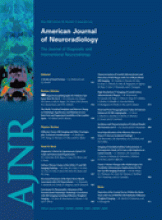Research ArticleSpine Imaging and Spine Image-Guided Interventions
Assessment of Craniospinal Arteriovenous Malformations at 3T with Highly Temporally and Highly Spatially Resolved Contrast-Enhanced MR Angiography
R.S. Saleh, D.G. Lohan, J.P. Villablanca, G. Duckwiler, S.T. Kee and J.P. Finn
American Journal of Neuroradiology May 2008, 29 (5) 1024-1031; DOI: https://doi.org/10.3174/ajnr.A0947
R.S. Saleh
D.G. Lohan
J.P. Villablanca
G. Duckwiler
S.T. Kee

References
- ↵Mast H, Young WL, Koennecke HC, et al. Risk of spontaneous haemorrhage after diagnosis of cerebral arteriovenous malformation. Lancet 1997;350:1065–68
- ↵Ondra SL, Troupp H, George ED, et al. The natural history of symptomatic arteriovenous malformations of the brain: a 24-year follow-up assessment. J Neurosurg 1990;73:387–91
- ↵Graf CJ, Perret GE, Torner JC. Bleeding from cerebral arteriovenous malformations as part of their natural history. J Neurosurg 1983;58:331–37
- ↵Wilkins RH. Natural history of intracranial vascular malformations: a review. Neurosurgery 1985;16:421–30
- Hartmann A, Mast H, Mohr JP, et al. Morbidity of intracranial hemorrhage in patients with cerebral arteriovenous malformation. Stroke 1998;29:931–34
- ↵Luessenhop AJ, Rosa L. Cerebral arteriovenous malformations: indications for and results of surgery, and the role of intravascular techniques. J Neurosurg 1984;60:14–22
- ↵Kader A, Young WL, Pile-Spellman J, et al. The influence of hemodynamic and anatomic factors on hemorrhage from cerebral arteriovenous malformations. Neurosurgery 1994;34:801–07, discussion 807–08
- Spetzler RF, Hargraves RW, McCormick PW, et al. Relationship of perfusion pressure and size to risk of hemorrhage from arteriovenous malformations. J Neurosurg 1992;76:918–23
- Marks MP, Lane B, Steinberg GK, et al. Hemorrhage in intracerebral arteriovenous malformations: angiographic determinants. Radiology 1990;176:807–13
- ↵Redekop G, TerBrugge K, Montanera W, et al. Arterial aneurysms associated with cerebral arteriovenous malformations: classification, incidence, and risk of hemorrhage. J Neurosurg 1998;89:539–46
- ↵Hankey GJ, Warlow CP, Sellar RJ. Cerebral angiographic risk in mild cerebrovascular disease. Stroke 1990;21:209–22
- Willinsky RA, Taylor SM, TerBrugge K, et al. Neurologic complications of cerebral angiography: prospective analysis of 2,899 procedures and review of the literature. Radiology 2003;227:522–28
- ↵Dion JE, Gates PC, Fox AJ, et al. Clinical events following neuroangiography: a prospective study. Stroke 1987;18:997–1004
- ↵Nael K, Villablanca JP, Saleh R, et al. Contrast-enhanced MR angiography at 3T in the evaluation of intracranial aneurysms: a comparison with time-of-flight MR angiography. AJNR Am J Neuroradiol 2006;27:2118–21
- ↵
- ↵
- ↵
- ↵Carr JC, Ma J, Desphande V, et al. High-resolution breath-hold contrast-enhanced MR angiography of the entire carotid circulation. AJR Am J Roentgenol 2002;178:543–49
- ↵Cognard C, Casasco A, Toevi M, et al. Dural arteriovenous fistulas as a cause of intracranial hypertension due to impairment of cranial venous outflow. J Neurol Neurosurg Psychiatry 1998;65:308–16
- Collice M, D'Aliberti G, Talamonti G, et al. Surgical interruption of leptomeningeal drainage as treatment for intracranial dural arteriovenous fistulas without dural sinus drainage. J Neurosurg 1996;84:810–17
- Duffau H, Lopes M, Janosevic V, et al. Early rebleeding from intracranial dural arteriovenous fistulas: report of 20 cases and review of the literature. J Neurosurg 1999;90:78–84
- ↵Thompson BG, Doppman JL, Oldfield EH. Treatment of cranial dural arteriovenous fistulae by interruption of leptomeningeal venous drainage. J Neurosurg 1994;80:617–23
- Davies MA, TerBrugge K, Willinsky R, et al. The validity of classification for the clinical presentation of intracranial dural arteriovenous fistulas. J Neurosurg 1996;85:830–37
- Satomi J, van Dijk JM, Terbrugge KG, et al. Benign cranial dural arteriovenous fistulas: outcome of conservative management based on the natural history of the lesion. J Neurosurg 2002;97:767–70
- ↵Van Dijk JM, TerBrugge KG, Willinsky RA, et al. Multidisciplinary management of spinal dural arteriovenous fistulas: clinical presentation and long-term follow-up in 49 patients. Stroke 2002;33:1578–83
- ↵
- ↵Margolis G, Odom GL, Woodhall B, et al. The role of small angiomatous malformations in the production of intracerebral hematomas. J Neurosurg 1951;8:564–75
- ↵
- ↵
- ↵Meckel S, Maier M, Ruiz DS, et al. MR angiography of dural arteriovenous fistulas: diagnosis and follow-up after treatment using a time-resolved 3D contrast-enhanced technique. AJNR Am J Neuroradiol 2007;28:877–84
- ↵Batjer H, Suss RA, Samson D. Intracranial arteriovenous malformations associated with aneurysms. Neurosurgery 1986;18:29–35
- ↵Perret G, Nishioka H. Report on the cooperative study of intracranial aneurysms and subarachnoid hemorrhage. Section VI. Arteriovenous malformations: an analysis of 545 cases of cranio-cerebral arteriovenous malformations and fistulae reported to the cooperative study. J Neurosurg 1966;25:467–90
- ↵
In this issue
Advertisement
R.S. Saleh, D.G. Lohan, J.P. Villablanca, G. Duckwiler, S.T. Kee, J.P. Finn
Assessment of Craniospinal Arteriovenous Malformations at 3T with Highly Temporally and Highly Spatially Resolved Contrast-Enhanced MR Angiography
American Journal of Neuroradiology May 2008, 29 (5) 1024-1031; DOI: 10.3174/ajnr.A0947
0 Responses
Assessment of Craniospinal Arteriovenous Malformations at 3T with Highly Temporally and Highly Spatially Resolved Contrast-Enhanced MR Angiography
R.S. Saleh, D.G. Lohan, J.P. Villablanca, G. Duckwiler, S.T. Kee, J.P. Finn
American Journal of Neuroradiology May 2008, 29 (5) 1024-1031; DOI: 10.3174/ajnr.A0947
Jump to section
Related Articles
- No related articles found.
Cited By...
- Color-Mapping of 4D-CTA for the Detection of Cranial Arteriovenous Shunts
- Time-Resolved Contrast-Enhanced MR Angiography of Spinal Vascular Malformations
- Noninvasive Evaluation of Cerebral Arteriovenous Malformations by 4D-MRA for Preoperative Planning and Postoperative Follow-Up in 56 Patients: Comparison with DSA and Intraoperative Findings
- The Predictive Value of 3D Time-of-Flight MR Angiography in Assessment of Brain Arteriovenous Malformation Obliteration after Radiosurgery
- Quality-Evaluation Scheme for Cerebral Time-Resolved 3D Contrast-Enhanced MR Angiography Techniques
- Cerebral Venous Thrombosis: Diagnostic Accuracy of Combined, Dynamic and Static, Contrast-Enhanced 4D MR Venography
- 4D Radial Acquisition Contrast-Enhanced MR Angiography and Intracranial Arteriovenous Malformations: Quickly Approaching Digital Subtraction Angiography
This article has not yet been cited by articles in journals that are participating in Crossref Cited-by Linking.
More in this TOC Section
Similar Articles
Advertisement











